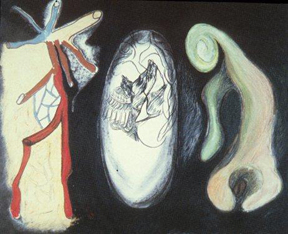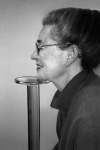
Joan Tanner
American , 1935-
Three Journeys a Night, 1986
oil pastel, charcoal and chalk on paper
32 x 40 in.
SBMA, Museum purchase with funds provided by Gail and Barry Berkus
1986.66

"In Three Journeys a Night there is a lineup of elements in a kind of rogue's gallery, an invented sequence of three distinctly different entities, vertically aligned specimens for acute scrutiny ... there is a reference to circulation of fluids, to early Chinese landscape drawing, and to the modeling of a living thing emerging as mammalian, possibly human-like." - Joan Tanner
RESEARCH PAPER
Joan Tanner was born on November 25, 1935, in Indianapolis, Indiana. She earned a Bachelor of Arts degree in Art Studio from the University of Wisconsin at Madison in 1957 with concentrations in both sculpture and painting. Early influences were Giorgio de Chirico and Fernand Léger.
She moved to Santa Barbara in 1965 and quickly became active in the local arts scene. She was a founding board member of the Contemporary Arts Forum, a Visiting Lecturer in Art Studio at UCSB and served as a member of the SBMA Exhibition and Acquisitions Committee. She has had numerous one-person and group exhibitions in Santa Barbara and throughout Southern California.
Her earliest paintings and drawings focused on the architectonic examination of windows invaded by dynamic shapes having to do with technology, such as coils, braids, and tubes. Geometric symbols such as cubes, cylinders, and ziggurats followed. As was the case with De Chirico, the continuing exploration of symbolism would ultimately evolve into a style with roots in surrealism.
Surrealism was a movement in the visual arts and literature that flourished in Europe between the World Wars. Its goal was to express the workings of the subconscious mind through fantastic imagery and incongruous juxtapositions of subject matter. As surrealism developed, two tendencies took hold. One, epitomized by Salvador Dali and René Magritte, employed perspective and other traditional techniques and mannerisms to achieve fixed-dream illusionism. The other, epitomized by Joan Miró and André Masson, developed biomorphic shapes in a cubist-related, flat-planed,shallow space.
By the mid 80s, Tanner's work had begun to utilize recurrent biomorphic forms such as the unwinding spirals of sea creatures or the interwoven curves of embryos, somewhat reminiscent of Miró. There was no narrative component to her work. She was interested in exploring forms as expressions the viewer could interact with, not as messages the viewer should understand.
Three Journeys a Night is fragmented by the juxtaposition of three different figures that seem intended to keep the viewer off balance: the medusa-like figure on the left with probing fingers and web-like appendages, the cameo-like, rounded ellipse in the center, and the elongated, curvaceous creature with spiral head on the right. The tension created by the use of complementary colors in the two outer figures is offset by the symmetry with which they balance around the center. Although the private world of her imagery is very much her own, by locating the images within a shroud of hovering darkness, she invites the viewer to put themselves in their own dreams and imagine what they might encounter: One might find the leftmost, for example, to be frightening, the middle evolutionary, the rightmost a comforting hand reaching out for companionship. The experience can also be impacted by whether the viewer proceeds from left to right, from right to left, or from the center outward. The challenge to viewers is to determine if and to what extent they are willing to probe their own subconscious minds through free association with the imagery.
Beginning in the 90s, Tanner began to extend the texture of her works by incorporating found materials like bits of paper, netting, beach debris, dryer lint, and then larger objects such as paint can lids and toys. Her technique evolved from collage into assemblage, culminating in site-specific installations. Her imagination was extraordinary. In her Apfelwerk series, 1995, she discovered that when steel brads were inserted into apples the brads reacted with the fruit acids to cause patterns of decay that would become encrusted with jewel-like molds. The relationship between sections of collapsed skin contrasting with intact portions would evolve as the fruit decayed during the course of the exhibition. And to fully challenge reality, she would not hesitate to mix in a few trompe l'oeil apples as well.
Most recently in her career she has focused on site-specific installations composed of constructed components using a wide variety of materials as well as found objects, sometimes painted in pure, expressionistic colors. On Tenderhooks , 2006, for example, was a large-scale installation at the Ben Maltz Gallery at Otis College of Art and Design, Los Angeles. Using raw materials like Blister-Pac, corrugated plastic paneling, galvanized metal, air-duct filters, plywood, industrialized coating, light, and video, Tanner assembled a precarious environment to tackle her favorite lifetime theme, the visual paradox of architectonic order and disintegration.
Prepared for the SBMA Docent Council by Mike Ramey, April, 2012.
Bibliography
Blakeney, Ray. "Painting in a Musical Idiom." Artweek 10.3 (1979), p. 6.
de Alcuaz, Marie et. al. Ceci N’est Pas le Surrealism: California Idioms of Surrealism. Los Angeles, CA: Fisher Gallery, University of Southern California, 1984. Exhibition Catalogue.
Dills, Keith. "Risks and Declarations." Artweek 17.26 (1987), p. 7.
DiMichele, David. "Joan Tanner at the Santa Barbara Contemporary Arts Forum," ArtWeek,
June 1995, p. 28.
Duncan, Michael. "Joan Tanner at Contemporary Arts Forum," Art in America, February 1996, p. 87.
Larson, Susan. Joan E. Tanner: California Viewpoints. Santa Barbara, CA: Santa Barbara Museum of Art, 1986. Exhibition Catalogue.
Linton, Meg et. al., Joan Tanner On Tenderhooks, Los Angeles, CA: Otis College of Art & Design, 2006. Exhibition Catalogue.
Otis Ben Maltz Gallery. Joan Tanner "On Tenderhooks, the Movie," Web. 21 January 2009.
(http://www.youtube.com/watch?v=KK-STNx8aps&feature=player_detailpage)
Robson, Julian et. al. Close Scrutiny: The Art of Joan Tanner. Santa Barbara, CA: Contemporary Arts Forum, 1995. Exhibition Catalogue.
Rush, David. "Five Artists, Five Views." Artweek 6.33 (1975): 15.
Smith, David. Surrealism is Alive and Well in the West. Pasadena, CA: Baxter Art Gallery, California Institute of Technology, 1984. Exhibition Catalogue.
Starkey, David. "Joan Tanner," The Creative Community. Web. 4 January 2011.
(http://www.vimeo.com/20579548)
Tanner, Joan. Joan Tanner. Web. 2013.
(http://www.joantanner.com)
Tanner, Joan. Turnings. Isla Vista, CA: Edition Reese of Turkey Press, 1990-92.
